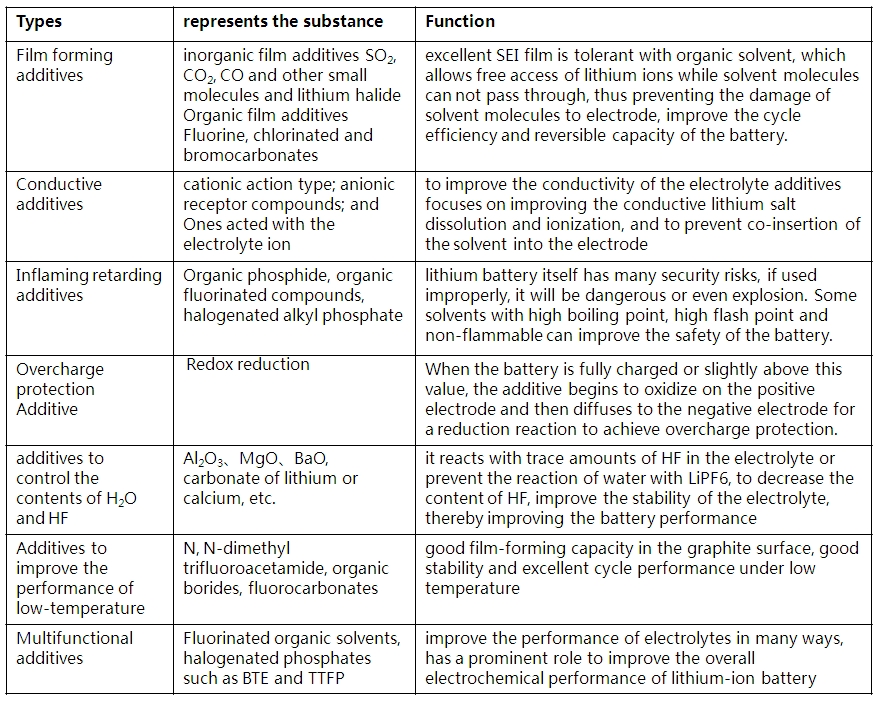2017-09-13
As one of the key materials of lithium-ion batteries, the positive and negative anodes of the battery are connected with electrolyte, which not only has a higher lithium ion conductivity, but also has an excellent electronic insulation. Because it plays a vital role to the performance of lithium batteries, it has been one of the hot spots. Lithium-ion battery electrolyte is mainly composed of three parts: organic solvents, lithium salts, and additives, in this article, we will make a brief summary of the materials used in lithium-ion battery electrolyte.
Organic solvents
The organic solvent is the main part of the electrolyte, which is closely related to the performance of the electrolyte. Therefore, quality, purity and moisture must be strictly controlled. The commonly used solvents in lithium-ion batteries electrolyte are ethylene carbonate (EC), diethyl carbonate (DEC), dimethyl carbonate (DMC), ethyl methyl carbonate (EMC), propylene carbonate (PC) and methyl propyl carbonate (MPC), etc., the specific performance are shown in the following table (Table 1):
Table 1. The commonly used organic solvents in lithium-ion battery electrolyte and their characteristics.
|
Organic solvent |
properties |
|
EC |
strong hygroscopicity |
|
DEC |
Hygroscopic, insoluble in water, soluble in alcohol, ether and other organic solvents, flammable and explosive |
|
DMC |
strong hygroscopicity, soluble in ethanol, ether and other organic solvents, insoluble in water |
|
EMC |
strong hygroscopicity, insoluble in water, soluble in alcohol, ether, chemical instability, easily decomposed into alcohol and carbon dioxide |
|
PC |
strong hygroscopicity |
|
MPC |
strong hygroscopicity |
Lithium Salt
Electrolyte lithium salt should be easy to dissolve in organic solvent, easy to dissociate to ensure that the electrolyte has good conductivity; it should has good electrochemical stability and chemical stability; and with environmental friendliness; it is easy to prepare and purified, and the price is cheaper. The commonly used electrolyte lithium salts are LiBF4, LiPF6, LiAsF6, LiClO4, LiBOB, etc., the simple differences are shown in Table 2:
Table 2. The commonly used lithium salt in lithium-ion batteries and their performances
|
Lithium Salt |
advantages |
disadvantages |
|
LiBF4 |
Good low temperature performance expensive |
low solubility |
|
LiPF6 |
Good comprehensive performance |
easy to absorb water |
|
LiAsF6 |
Good comprehensive performance |
toxicity |
|
LiClO4 |
Good comprehensive performance |
strong oxidation, low safety |
|
LiBOB |
better high temperature performance |
low solubility |
Electrolyte additives
There are a wide variety of additives, and they have different focuses, including film forming additives, conductive additives, inflaming retarding additives, overcharge protection additives, additives that control H2O and HF content in electrolyte, additives to improve the performance under low temperature, multi-functional additives, the details are shown in Figure 1:

Figure 1. The commonly used additives for lithium-ion batteries
In general, lithium-ion battery electrolytes should generally have high ionic conductivity, high thermal stability and chemical stability, wide electrochemical window, and good compatibility with other parts of the battery, safe, non-toxic, non-polluting, etc. In recent years, the global lithium-ion battery electrolyte industry is developing steadily, domestic electrolyte has already gradually entered into the market to replace the imported ones (Such as domestic manufacturers have been able to produce hexanetriazole and T3P), through continuous improvement, domestic product has reached the international advanced level.
Copyright © Suzhou Yacoo Science Co., Ltd. All Rights Reserved
Friendly Links :
online service